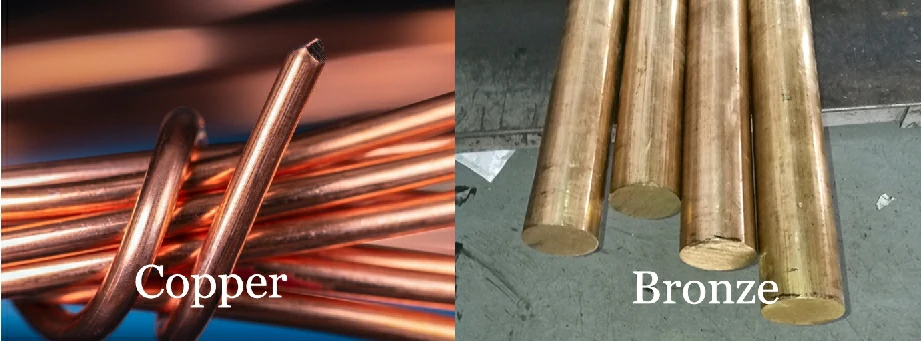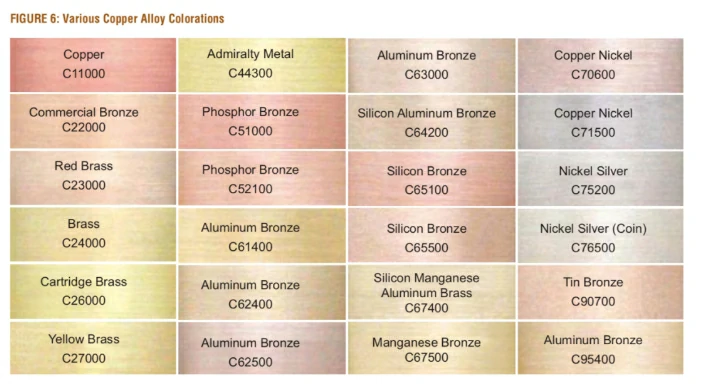
In the manufacturing industry, copper and brass are two common and important metals. However, when we talk about their colors, many people may feel confused, thinking that the color difference between them is not significant. But in fact, although the two are similar in appearance, there are subtle differences in the details of color.
Let’s delve deeper into the color nuances of Copper and Bronze to understand their differences.
Copper

Copper, as we know, is pure copper, and its color is quite distinctive. The color of copper can be influenced by its purity and processing methods. The higher the purity of copper, the closer its color tends to be to a golden hue. When Copper is newly cut or polished, it exhibits a bright, reddish-orange hue with a metallic gloss. This hue gives Copper its nickname of “red copper” or “pure copper.”
Additionally, copper subjected to special treatments such as electrolytic refining may develop a smoother surface with a more uniform oxide film, resulting in a brighter appearance.As it ages, it may develop a patina, which gives it a more muted, earthy tone, but its original reddish hue remains prominent.
Bronze

Bronze is an alloy of copper primarily mixed with tin, although other elements like aluminum, silicon, phosphorus, or arsenic may also be added.
The color of Bronze is a rich, warm yellow or brownish hue, depending on the composition and treatment. It has a deeper, more earthy tone compared to Copper, often appearing golden or amber-like. Bronze’s color is also more stable and doesn’t change much over time, unlike Copper, which can oxidize and change color.
Different Copper Alloys and Their Color Matching
Unlike the coloration mechanism of paint, the color of copper alloys is manifested through their inherent physical and chemical properties, which do not fade or lighten over time.
Different copper alloys, due to differences in their composition, exhibit different absorption and reflection characteristics of light, thus presenting different colors.

Differences Between Copper and Bronze
You can distinguish them by the following information:
Melting Point
The melting point of copper is 1083°C. In contrast, bronze, compared to copper, exhibits higher strength and a lower melting point (for example, bronze alloyed with 25% tin can have a melting point reduced to 800°C).
Elemental Composition
Copper is a natural metal typically found in its elemental state and can be directly used in compatible manufacturing processes.
Bronze, on the other hand, is an alloy primarily composed of copper mixed with other metallic elements. Specifically, bronze is primarily composed of elements such as tin (Sn), lead (Pb), aluminum (Al), iron (Fe), nickel (Ni), manganese (Mn), silicon (Si), phosphorus (P), and others.
For bronze alloys with specific requirements, alloying elements such as beryllium (Be), magnesium (Mg), silver (Ag), chromium (Cr), cadmium (Cd), zirconium (Zr), tellurium (Te), and others may be added to enhance their performance.
Corrosion Resistance
Compared to copper, bronze exhibits strong corrosion resistance. When exposed to corrosive environments, bronze forms a protective layer on its surface, effectively preventing further corrosion. Therefore, it is highly suitable for manufacturing components used in marine environments.
While copper also possesses good corrosion resistance, it may be affected in certain specific environments. Nevertheless, copper’s corrosion resistance still meets requirements in many fields. For instance, in the electrical and electronic industries, pure copper is widely used in the production of conductive components such as wires and cables.
Conclusion
For many consumers, the appearance of these two metals may be similar, but their composition, performance, and price differ significantly. Therefore, mastering the correct differentiation method is crucial. This article delves into the color differences between copper and bronze. If you still encounter problems or confusion in the process of identifying copper and bronze materials, the BOYI team is always ready to provide professional guidance and advice. We have rich experience and professional knowledge to provide you with answers and assistance. Please feel free to contact us at any time.
FAQ
The natural tone of copper is generally warmer and tends to be lighter in color. If you’re looking for a lighter-colored metal, copper might be the better choice, while bronze offers a deeper, richer hue.
Bronze offers higher strength, lower melting point, and excellent corrosion resistance, making it preferable for certain uses like marine components. Copper, on the other hand, excels in electrical conductivity and is often preferred for electrical applications.
Bronze tends to be more expensive than copper due to its unique properties and the additional processing required to create it.
Tagged: Materials Guide



